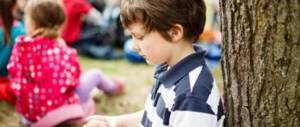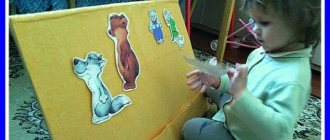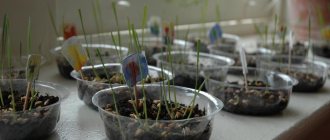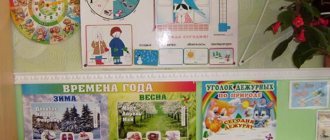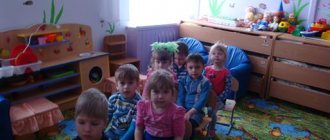Preview:
Nowadays, children lack optimism, emotional calm, the ability to rejoice, self-sufficiency and the ability to adapt to difficult life situations. A large percentage of kindergarten students are children who express emotions of anger with aggression, who do not know how to negotiate, who have difficulty adapting to life in a group of children and who do not respect the other person, his feelings, mood and emotions. Accepting yourself for who you really are is a sign of mental health and an indicator of personal growth. Self-acceptance largely determines the nature of interaction with other people. Therefore, the development of this feeling must be given serious attention and developed in children.
In practice, all psychologists are faced with the fact that their efforts, no matter how diligent they may be, without the support of educators, unfortunately, do not achieve a positive result. The psychological corner is a real tool in the hands of the teacher for effective psychological support for children during the day.
The relevance of the problem of preserving and strengthening the psychological health of preschool children is obvious. To solve it, it is necessary to create appropriate conditions and organize the subject environment. Thanks to the psychological corner, the child has the opportunity to relax, eliminate anxiety, excitement, stiffness, relieve excess tension, restore strength, increase energy, and feel protected, since there is often a moment when it is necessary to retire. When selecting material for psychological corners, you need to take into account the needs of children. Some people want to take a break from the children's group, think about their mother, sit in silence, some need psycho-emotional relief, some children are aggressive and need help throwing out their aggression so as not to harm other children and not keep it to themselves. Therefore, we are faced with the task of teaching children acceptable forms of expressing aggression and creating all the conditions for this.
Corner of psychological relief
Larisa Potemina
Corner of psychological relief
Slide No. 2 The relevance of the problem of preserving and strengthening the psychological health of preschool children is obvious. We live in an era of crises and social change. The economic and value instability of society has a negative impact on our preschoolers. This is confirmed by children with disorders of psycho-emotional development .
Slide No. 3,4 “Mood clearing”
Helps children understand their own emotions and the emotional states of others. The mirror of emotions performs the same task. The child sees himself and tells everything good about himself, with the help of facial expressions he learns to understand the state of his comrades.
Slide No. 5 “Magic objects”
: a hat, a wand, a cloak help the teacher, together with the children, make wonderful journeys and transformations, make communication with children fabulous, full of pleasant surprises.
Slide No. 6 “Box of Secrets”
allows the child to relax, helps relieve tension, and improves mood.
It contains various pieces of fabric, small toys made of different materials, and pieces of fur. The child closes his eyes, the teacher runs any object along his hand with the question “What is this?
Guess?" You can simply look at objects and touch them.
Slide No. 7 “Bag of Joy”
made of blue material with a corresponding image of a good mood face.
The “Bag of Sadness”
is made of black material with a corresponding image of a face in a bad mood.
The bags are tied with elastic bands. If a child is in a bad mood, he can take a bag and “put”
grievances and anger into it. Then from another bag he takes a good mood, laughter, smile, joy.
Slide No. 8 “Basket with balls of multi-colored threads”
Their goal: to calm down naughty children and teach them one of the techniques of self-regulation.
By winding bright yarn into a ball, the child calms down. Games with balls: “Binding Thread”
,
“Magic Ball”
,
“Nimble Ball”
.
Slide No. 9 “Rug of Anger”
designed to relieve emotional stress and express such negative emotions as anger in a form acceptable to others.
For the same purpose, there are shouting cups the corner
Slide No. 10 The presence of soft sofas with “emotion” the corner
, gives you the opportunity to relax.
Slide No. 11 “Wall of Mood Changes”
. Children use their hands or feet to move from a sad image to a more cheerful one, while conveying the depicted emotion. They are distracted from their negative experiences, forget about them, thus improving the microclimate in the group.
Slide No. 12, 13 “Umbrella”
,
a corner of solitude . There the child feels protected and can play quietly. The house allows you to “hide”
from the outside world, keep secrets, and look at albums with photographs.
Slide No. 15 “Mirilka Box”
.Goal: to teach children various ways of reconciliation after a quarrel.
Slide No. 16 D/i “The ABC of a good mood”
.Goal: teaching children conflict-free communication.
“Portrait of a good me”
- the child puts a frame in front of himself and tells all the good things about himself.
The other children tell you if the narrator missed something. This is how children create their positive “I-image”
.
Attached files:
| ugolok_m44f2.pptx | 13129.67 KB |
Music as a condition for the emotional well-being of preschool children in accordance with the Federal State Educational Standard for preschool education Slide No. 1 Title. Slide No. 2 of the Federal State Educational Standard, its documentary basis, basic principles and first task. Slide No. 3 Emotional well-being of a preschooler.
Creative and educational project “Glory to the dear army” for children of senior preschool age (5–7 years old) Project theme: “Glory to the dear army” Age of children: 5-7 years Type of project: creative, educational Type of project: short-term Problem: absence.
Preview:
Regulations on the review-competition “Best Psychological Corner”
- Goals and objectives of the competition
- Creating conditions for preserving the psychological health of each child;
- Intensifying the activities of the teaching staff in the design and competent use of materials from psychological corners for the full psychophysical development of preschool children
- Involving parents in providing comprehensive assistance to groups in conducting a review competition
- Participants of the competition
- Teachers of all age groups can take part in the competition.
- A prerequisite for the review and competition is the participation of preschool students
- Events to prepare the competition
- The senior teacher should prepare recommendations and samples for creating psychological corners.
- Conduct individual consultations with teachers.
- To work through the main issues for preparing the workshop “Preserving the psychological health of students”
- Criteria and work procedure of the competition jury
- The work of the competition participants is assessed by a jury consisting of:
Chairman - Head of the Kindergarten
senior teacher
educational psychologist
Chairman of the trade union committee of the kindergarten
- Each jury member looks at the psychological corner in each group and conducts a conversation with the children.
- Assessment of psychological corners is carried out according to the following criteria:
- Availability of a zone for psychological relief in the group
- Material for teaching aggressive children how to express anger in an acceptable way
- Emotionally educational games aimed at teaching children conflict-free communication
- Material aimed at increasing self-esteem for anxious, insecure children
- Materials for teaching children cooperation skills and coordinated actions
- Aesthetics of the design of a psychological corner
- Presentation of the psychological corner by the group teacher
- Children's story about the psychological corner
- Working with parents.
- Procedure for holding a review-competition
- The review competition is held from ____ to ____
- The organizers of the competition have the right, if necessary, to make changes and adjustments to the procedure for its conduct.
- Rewarding and encouraging the winners of the competition
6. 1 The winners of the competition are awarded with certificates and letters of gratitude from the kindergarten administration.
Equipment for a psychological corner
| Purpose | Materials |
| Area for psychological relief | Corner for privacy (marquee, tent, etc.), upholstered furniture, “Chair of Reflections”, “Memories of Summer” - shells, flowers, etc., photo albums with group and family photographs, “Mom’s palms” - — mittens sewn by mother's hands, soft toys |
| Teaching aggressive children ways to express anger in an acceptable way | Punching bag, foam pillows, screaming cups, targets, “Anger Pillow”, “Bad Mood Bank”, “Aggressive Mat” - prickly, shells. |
| Teaching children the ability to control themselves in various situations, self-regulation techniques | Audio-video recordings (sound of the sea, sounds of the forest, music for rest, relaxation), colored balls, magic objects (hat, cloak, wand, shoes, etc.), games with sand, water, cereals, buttons, “Bags” moods" - a bag of good moods, a bag of bad moods, "Boxes of good deeds." |
| Teaching children conflict-free communication using emotional and educational games | “The ABC of Moods”, “Friendship Rug”, board games, didactic games: “What is good? What is bad? etc., a box with little people, “Reconciliation Pillow”, “Reconciliation Box”, “Reconciliation Island”, “Reconciliation Rug”, “Mood Board”. |
| Increasing the self-esteem of anxious, insecure children | Podium, stand - “Hero of the day”, medals, “Sleepy toys”, “Scoops owl pillow”, “Chair of honor”, |
| Teaching children cooperation skills and coordinated teamwork. | "Twister", "Caterpillar", "Fun Rug". |
I often have to deal with what my parents consider to be something wrong and abnormal. When a child openly expresses his anger, we, parents, do not know how to react.
Let's talk a little about this.
Examples of games using psychological corner materials
Examples of games using materials from the psychological corner
Games with balls
Goals: calm down naughty children, teach them one of the techniques of self-regulation.
Equipment: balls of dense thread.
The teacher invites the naughty child to wind bright yarn into a ball. The size of the ball can become larger each time. The adult tells the preschooler that this ball is not simple, but magical. As soon as the child begins to wind it up, he calms down.
When such a game becomes habitual for a preschooler, he himself will ask the teacher to give him “magic threads” every time he feels that he is upset, tired or “wound up.”
Option 2
(L.V. Kuznetsova, M.A. Panfilova)
Goals: developing a sense of belonging to the group, safety in the team; unity, cohesion; the ability to act in concert.
The teacher and children stand in a circle. The teacher sings a song and wraps the thumb of his right hand. Then he passes the ball to the next child, calling him by name in the song, etc. When the song ends, all the children and the teacher are connected by a thread. The ball must return to the teacher, having completed a full circle. Then, at the same time, everyone carefully removes the thread from their fingers and places it on the table. The children's attention is drawn to the fact that the thread has not broken and the guys in the group will always be just as strong friends. In conclusion, you can ask the students to remember proverbs and sayings about friendship.
Game “Bags of Moods”
Goal: to teach children to get rid of bad moods in an acceptable way.
Equipment: two bags. One of light material with the image of a face in a good mood. This is a bag of joy, good mood, smiles, fun, etc. The second is a bag of bad mood made of dark material, it depicts a face in a bad mood. The bags are tied with laces.
Having found out which of the students is in a bad mood, the teacher invites them to use the bags. Children untie their shoelaces, “put” their bad mood, anger, and grievances into a bag with a bad mood and carefully tie the shoelace. Then they untie the string on the bag with a good mood and take from there a good mood, smiles, laughter, joy.
Game “Pillow of Reconciliation”
Goal: to teach children various ways of reconciliation after a quarrel.
Equipment: a cushion for two children to sit on. Gloves are sewn onto it with elastic bands.
Children who have quarreled sit down on a pillow, put on gloves and make peace, reciting various peace poems.
Goal: to teach children various ways of reconciliation after a quarrel.
Equipment; a bright box with holes on all sides of various shapes.
Children who have quarreled put their hands through different sides of the box, find each other’s hands inside, greet each other and make peace, reciting different peace poems.
Game “Boxes of Good Deeds”
(L.V. Kuznetsova, M.A. Panfilova)
Goals: to teach a sensitive, friendly attitude towards comrades; encourage children to act morally; to cultivate feelings of respect for people: goodwill, the desire to do good deeds. Preliminary work with children:
reading the works of V. Oseeva “The Magic Word”, “Just an Old Lady”; A. Barto “Vovka is a kind soul”;
conversations on the topic: “A friendly attitude towards comrades”, “What would you do?”, “Strength is not right”, “The one who gives in is smarter”, “Conversation about politeness”, “Always help people”, “About good people” ”;
riddle stories about good and bad deeds.
Equipment: boxes of different sizes and colors, each child has his own box.
The teacher shows and tells the children that these are not simple boxes - they contain good deeds and good deeds. Now they will mark every good deed and kind deed with chips, putting them in a box. When the week is over, children will be able to see whose box has the most chips. Which of the preschoolers will do the most good deeds and wonderful deeds will deserve a prize.
Playing with sleepy toys
(L.V. Kuznetsova, M.A. Panfilova)
Goals: reducing anxiety, aggression, general anxiety and neuroticism during the period of child adaptation to kindergarten; creating positive motivation for a routine moment of sleep; improving the emotional background and developing a sense of confidence.
Equipment: soft toys (safe animals) ranging in size from 10 to 20 cm are located on a special shelf in the bedroom (according to the number of children). For children with bad habits, as well as for hyperactive children - toys with filling. A disc with slow, calm music for falling asleep and waking up.
The teacher draws the children’s attention to the shelf with toys and explains: “These are sleepy toys. They will help you fall asleep and have fabulous dreams.” The music sounds quietly to which the beds are being made. Together with the toy, the teacher approaches the children in turn, who are in bed, and whispers to each one, calling him an affectionate word, emphasizing his positive character traits, behavior, etc., instilling in him a sense of confidence, increasing self-esteem. For example: “You tried so hard in class today that the little bunny chose you to sleep with. He whispers sweet words to you (you can say them), and you whisper something pleasant to him too and caress him.”
Anger and anger of a child.
Anger and anger are natural human feelings that we all experience from time to time. These feelings express emotions directed against experienced injustice or as a reaction to a situation that prevents the satisfaction of a need.
Aggression is physical actions towards another person, expressed in an attack or threat of attack, associated with the emotions of anger, fear, rage, etc.
When we, adults, experience anger, anger, irritation, we most often know what exactly is happening to us and how we can deal with it.
We can express our feelings, suppress, hide, tell our friends or loved ones about them, we can kick the sofa out of anger, smoke a cigarette, stand in the shower, hit the table with our fist, throw something, etc., etc. .
As a rule, we do not show aggression towards others, because... We know that we will cause them great discomfort, and therefore we use various other ways to cope with our anger.
When children feel angry, they do not understand what is happening to them, what it is called and what to do about it. They may say: “Get away from here,” “You’re a fool,” “Bad mom,” “I hate you,” “I won’t be friends with you.”
And very rarely can a child say: “I’m angry with you” if you have never taught him this.
Children experience life “totally”, they are in the present moment with their whole being, they are spontaneous and sincere in expressing their feelings, they live “here and now” and are often at the mercy of emotions.
It is very important that parents do not forbid the child to show feelings of anger (and any other feelings too), do not shame him for it or scold him, but, on the contrary, help him.
How can you help your child express his feelings?
When a child is angry, parents need to help him.
1) Help the child realize what is happening to him using words, voice his feelings, explain what is happening to him now. For example: “I see that you are angry now.” “I understand that you’re angry right now.”
2) Show that you understand what exactly the child is angry about: “I see that you are very angry because you want to play with my phone, but I don’t allow you,” “You are angry with me because something happened.” ...”, “because you want...”, “because they don’t give you...”.
3) Say that you understand him: “I understand you, I would also be angry if I were you”, “I understand, I also don’t want to finish interesting things”, “I also got angry when I was little in such cases...”.
4) Help the child say in his own words what he feels. Teach your child to say: “I’m angry,” “I’m angry,” “I’m so angry that I want to throw everything around here,” “I’m so angry that I want to hit you.”
After all, such thoughts arise in a child, you just don’t know about it. Saying it doesn’t mean doing it at all. Let your child tell you what he feels and thinks and he will immediately feel better.
5) Outline restrictions on physical and verbal aggression towards people and animals, teaching the child to redirect his anger to other inanimate objects, that is, to express it in acceptable ways.
How to redirect a child’s anger?
Offer your child options to relieve tension and “discharge” his anger: “When you are very angry, you cannot hit others, you can do this (your choice):
Let's go with you:
- Let's beat the pillow with our hands! - let's leave the pillow! - Let's kick the pillow with our feet! – we leave soft toys (in the basket, on the floor, on the sofa). – let’s crumple the sheets of paper into a ball! (ordinary A4 sheets sharply crumple into a lump in 1 second). – we throw paper balls into the wall or each other! - let's tear the paper! – we’ll call the vegetables names: “You’re an eggplant! Your turn!”, “You are a carrot,” “You are a cabbage!” – let’s draw someone you’re angry with and then tweet him. – we’ll blind the one you’re angry with, and then we’ll crush him.
All this must not just be said, but must be demonstrated to the child, shown how to do it and involve him in the process.
Every time you see your child getting angry, voice his feelings, show understanding and support, and offer him one of the options above. Most likely, over time, he will develop his own favorite way and will be able to cope without you.
In this way, you help the child release tension, discharge his negative emotions, and at the same time he will not harm himself, adults or other children.
You show that you respect the child’s feelings, but at the same time set certain restrictions on their expression.
You prohibit aggression, but help the child cope with and express feelings of anger in other ways.
PS It wouldn’t hurt for Mom and Dad to have a pillow fight with each other from time to time either. Tested by parents! 
All the best to you!
Slide 1
Psychological corner in a kindergarten group.
Prepared by teacher-psychologist GBDOU No. 130 Nevsky district of St. Petersburg Gachevskaya N.A.
Slide 2
Everyone knows that preschool children are especially emotional and impressionable. They easily pick up strong, both positive and negative emotions of the people around them. In many ways, children's reaction to the situation around them depends on the teacher creating in them a sense of confidence and support, internal security and freedom. It also depends on his goodwill, acceptance of children as they are, and the ability to be a partner and comrade for them.
Slide 3
A child, while in kindergarten, experiences many stressful factors: - morning separation from parents; - a large number of children in the group; — a strictly regulated and busy daily routine (many classes and events, little free time for spontaneous interaction with peers); - the need to constantly obey the requirements and instructions of the teacher; - low level of self-regulation and communication skills (due to age and little life experience).
Slide 4
Tasks of the psychological corner in the group:
relieve psycho-emotional stress, fatigue; help calm down; remove the aggressive state; - improve your mood.
Slide 5
A place for privacy
Equipment for a psychological corner.
Slide 6
Pillows: “Girlfriends” for reconciliation “Clappers”
When a child fights, you need to explain to him that hitting children is bad, it hurts and offends them, but hitting a pillow is very possible.
Slide 7
Massage balls, colorful balls, and plasticine help relieve muscle tension and calm down. With their help, children master self-regulation techniques.
Slide 8
Bags of cereal for throwing and targets are also a way to safely display aggression.
Rug for anger. Children know that if they are angry, they need to stomp on the rug and the anger will go away.
Bucket for fears. Children draw their fears and get rid of them by throwing them into a bucket.
Cans, glasses for screaming. If a child is angry or offended at someone, he can express his resentment in a glass and he will feel better.
Slide 9
Pictograms with different moods. In the morning and throughout the day, the child can use emotional pictures to show his mood. Thanks to this, it is easier for the teacher to find an approach to a sad, upset child and provide him with support.
If a child is in a bad mood, he can “put” it in the “sad” bag, and “take” a good mood from the “cheerful” bag.
Slide 10
In the psychological corner you can place various fun devices for breathing exercises.
Slide 11
Psychomuscular gymnastics.
Exercise "Pinocchio"
Exercise "Butterfly"
According to the existing requirements for the organization of a developmental environment in educational institutions, it is necessary to create comfortable conditions in preschool educational institutions not only for active activities of pupils, joint games, classes under the guidance of a teacher, but also for children’s recreation. When spending the whole day in a noisy group, a child may need personal space. To do this, place it in the “Privacy Corner”. What such a zone is, how to make it with your own hands and what items to fill it with, we will tell you in this article.
The purpose of the “Privacy Corner” in kindergarten
- “Who’s in what mood?”
- “Complete the smiley face.”
- "Put the puzzle together."
- “Our emotions” and others.
Favorite books will also help your child cope with a bad mood.
Materials in the recreation area should be updated regularly. But it is recommended to leave the basic elements unchanged so that the baby feels comfortable in a familiar environment.
We shared ideas on how to create a “Privacy Corner” in kindergarten. But we note that there are no strict recommendations here - the teacher needs to listen to his students, their wishes, preferences and create a completely unique zone of comfort, psychological safety and good mood.
Mood corner “Traffic light of emotions”
Description of work:
This material is recommended for preschool teachers who work with children of middle preschool age. This manual allows you to track the mood of children coming to kindergarten and monitor changes in mood throughout the day.
This panel is made of three circles connected to each other using a satin ribbon. Photos of children are attached to clothespins.
Target
: improve children’s ability to determine their mood
Tasks:
Educational:
Develop the ability to analyze events over time and determine mood.
Promote the development of speech, develop the desire to talk about the reasons for changes in your mood.
Developmental:
Develop fine motor skills and color perception
Develop observation skills.
Educational:
Develop the ability to empathize with each other and share joy.
Material:
thick cardboard, self-adhesive film, Moment glue, Titan glue, satin ribbon, compass, ruler, clothespins, thick plastic (paper folder), photographs of children.
Also in the corner of solitude there can be various educational games and toys:
Theater screen with a set of toys for theatrical activities (Bi-ba-bo, finger);
Tactile, sensory mats;
Mosaic, puzzles;
Games for developing fine motor skills (stringing, sorting by shape, by color);
Lacing;
Balls of multi-colored threads (for unwinding and rewinding);
Patchwork panel;
Didactic games for studying emotional states: “Feelings and emotions”, “What friends act”, “Guess the emotion”, “Find friends”, “Events and emotions”, “My feelings”, “Emotions in fairy tales”.

